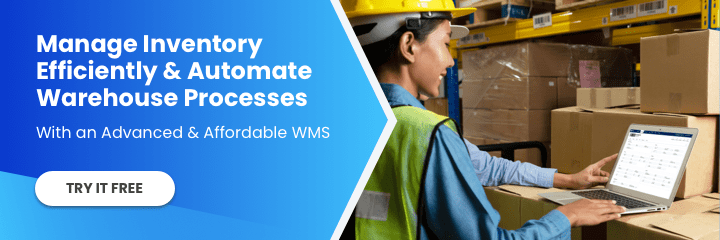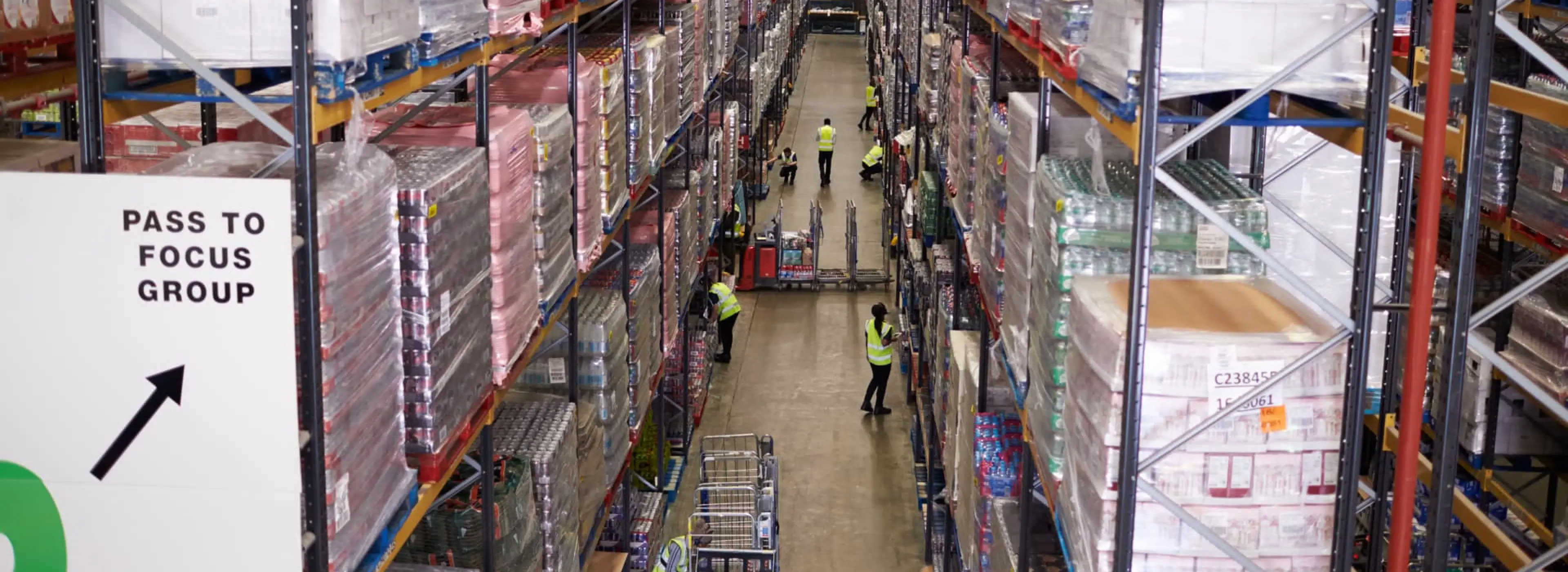For more information about boosting warehouse efficiency or the latest warehouse technology trends, you can follow us on LinkedIn, YouTube, X, or Facebook. If you have other inquiries or suggestions, please contact us here.
The heartbeat of any successful e-commerce business lies in its fulfillment center operations. The ability to swiftly and accurately process orders is pivotal, directly influencing customer satisfaction and paving the way for business growth. In this article, we’ll talk about strategies for small business owners and logistics veterans, offering insights to refine every facet of fulfillment center operations.
Click Here: Streamline Your Operations Using This Advanced and Affordable WMS
From leveraging cutting-edge technologies to fostering collaboration among your team, we delve into practical measures to enhance efficiency, trim costs, and boost overall productivity. Beyond the nuts and bolts, we emphasize the human element—training and motivating employees to achieve their best. Dive into our comprehensive exploration of fulfillment center operations to unlock the potential of your e-commerce venture.
What is a Fulfillment Center?
A fulfillment center is a large warehouse used by companies and e-commerce businesses to store, pick, pack, and ship products to customers. These facilities are a crucial part of the supply chain and logistics network, enabling businesses to efficiently manage their inventory and deliver products to customers on time.

The Importance of Efficient Fulfillment Center Operations
Efficient fulfillment center operations are crucial for any e-commerce business that aims to succeed in today’s competitive marketplace. A streamlined and optimized fulfillment center can help you reduce costs, increase productivity, and improve customer satisfaction.
On the other hand, inefficient operations can result in delivery delays, stockouts, damaged products, and poor customer experiences. These issues can hurt your reputation and bottom line, leading to lost sales and dissatisfied customers.
That’s why it’s important to optimize your fulfillment center operations, from when your cargo is received to when it’s delivered to the customer. Doing so can ensure smooth and efficient operations, resulting in happy customers and a successful business.
Common Challenges Faced in Fulfillment Center Operations
Fulfillment center operations can present many challenges, mainly as your business grows and order volumes increase. Some of the common challenges include:
1. Inaccurate Inventory Management
One of the biggest challenges in fulfillment center operations is managing inventory accurately. If you don’t have a clear view of your stock levels, you risk running out of popular products or overstocking items that aren’t selling. Both scenarios can result in lost sales and wasted resources.
2. Inefficient Order Processing
Another common challenge is inefficient order processing. If your order processing system is slow or error-prone, it can lead to delays in delivery, incorrect shipments, and dissatisfied customers.
3. Ineffective Warehouse Layout
An ineffective warehouse layout can make finding and retrieving products quickly and efficiently difficult. A disorganized warehouse can lead to wasted time, misplaced products, and increased labor costs.
4. Poor Employee Training and Motivation
Finally, poor employee training and motivation can harm your fulfillment center operations. If your employees are not properly trained or are unmotivated, they may make mistakes, resulting in low productivity and poor-quality work.
6 Ways to Streamline Your Fulfillment Center Operations
Streamlining fulfillment center operations is crucial for improving efficiency, reducing costs, and providing better service to customers. Here are some tips to help you streamline fulfillment center operations:
1. Optimize Your Order Processing System
Optimizing your order processing system is one of the first steps in streamlining your fulfillment center operations. This involves ensuring that orders are processed quickly, efficiently, and accurately.
Here are some tips for streamlining your order processing system:
- Use a Centralized Order Management System
Using a centralized order management system can help you streamline your order processing by consolidating all orders in one place. This allows you to view and manage orders more efficiently, reducing the risk of errors and delays. - Automate Order Processing Tasks Using Workflow Automation
Automating order processing tasks, such as order confirmation emails, via workflow automation can help you save time and reduce errors. By automating repetitive tasks, you can free up your staff to focus on more strategic activities. - Use Barcode Scanners
Barcode scanners can help you speed up order processing by scanning barcodes on products and orders. This reduces the risk of errors and enables you to fulfill orders more quickly and accurately.
2. Optimizing Inventory Management
Effective inventory management is essential for streamlining your fulfillment center operations. By optimizing your inventory management, you can ensure that you always have the right products in stock while minimizing the risk of stockouts and overstocking.
Here are some tips for optimizing your inventory management:
- Use a Real-Time Inventory Management System
A real-time inventory management system can help you keep track of your stock levels because they are constantly updated. This allows you to make informed decisions about when to restock products, reducing the risk of stockouts and overstocking. - Implement a Demand Forecasting System
A demand forecasting system can help you predict future product demand, allowing you to plan your inventory levels more effectively. This can help you reduce the risk of stockouts and overstocking while minimizing storage costs. - Use ABC analysis
ABC analysis involves categorizing products based on their value and sales volume. This lets you focus on high-value products and ensure they are always in stock while minimizing the risk of overstocking low-value products.
3. Implementing Automation in Fulfillment Center Operations
Automation plays a crucial role in streamlining your fulfillment center operations. By automating repetitive and time-consuming tasks, you can save time, reduce errors, and increase productivity.
Here are some ways you can implement automation in your fulfillment center operations:
- Use Automated Storage and Retrieval Systems
Automated storage and retrieval systems can help you retrieve products more quickly and efficiently. This reduces the risk of errors and can help you fulfill orders more quickly. - Implement Automated Packaging Solutions
Automated packaging solutions can help you pack products more quickly and accurately. This reduces the risk of errors and can help you fulfill orders more quickly. - Use Automated Conveyor Systems
Automated conveyor systems can help you move products through your warehouse more quickly and efficiently. This reduces the risk of errors and can help you fulfill orders more quickly.
4. Effective Warehouse Layout and Organization
An effective warehouse layout and organization strategy are essential for streamlining your fulfillment center operations. By organizing your warehouse logically and efficiently, you can reduce the time and effort required to retrieve products, increasing productivity and reducing labor costs.
Here are some tips for effective warehouse layout:
- Use a Logical Product Placement Strategy
Placing products logically and consistently in specific warehouse locations can help you retrieve products more quickly and efficiently. This reduces the time and effort required to fulfill orders, increasing productivity and reducing labor costs. - Use an Efficient Picking Strategy
An efficient picking strategy, such as zone picking or batch picking, can help you fulfill orders more quickly and accurately. This reduces the risk of errors and can help you increase productivity. - Minimize Travel Time
Minimizing travel time for your employees can help you increase productivity and reduce labor costs. This can be achieved by placing popular products closer to the packing and shipping areas and using efficient picking strategies.

5. Training And Empowering Your Fulfillment Center Team
Training and empowering your fulfillment center team is essential for streamlining your operations. By providing your employees with the tools and knowledge they need to do their jobs effectively, you can increase productivity, reduce errors, and improve overall quality.
Here are some tips for training and empowering your fulfillment center team:
- Provide Comprehensive Training
Providing comprehensive training to your employees can help them understand their roles and responsibilities and ensure they have the knowledge and skills to do their jobs effectively. - Foster a Positive Work Culture
A positive work culture can help you improve employee motivation and job satisfaction. This can be achieved by promoting collaboration, recognizing achievements, and providing opportunities for growth and development. - Encourage Employee Feedback
Encouraging employee feedback can help you identify areas for improvement and make changes that will benefit your employees and your business. This can help you increase productivity, reduce errors, and improve overall quality.
6. Key Performance Indicators (KPIs) for Measuring Fulfillment Center Performance
Measuring your fulfillment center performance is essential for identifying areas for improvement and ensuring that your operations are running smoothly. Key performance indicators (KPIs) can help you track your performance and make informed decisions about your operations.
Here are some KPIs that can help you measure your fulfillment center performance:
- Order Lead Time
Order lead time measures the time it takes to fulfill an order from when it’s received to when it’s shipped. A shorter lead time indicates that your operations are more efficient and you deliver products to customers more quickly. - Order Accuracy Rate
Order accuracy rate measures the percentage of orders that are fulfilled accurately. A higher accuracy rate indicates that your operations are more efficient and that you deliver products to customers with fewer errors. - Inventory Turnover Rate
Inventory turnover rate measures how quickly you’re selling your inventory. A higher turnover rate indicates that you’re selling products more quickly and managing your inventory more effectively.
Conclusion: Taking Your Fulfillment Center Operations to the Next Level
Streamlining your fulfillment center operations is essential for ensuring efficiency, reducing costs, and delivering exceptional customer experiences. By implementing the strategies and best practices outlined in this article, you can optimize your operations from start to finish, resulting in a more competitive business.
Remember to focus on optimizing your order processing system, inventory management, and warehouse organization and layout. Implementing automation and utilizing technology can also help you save time, reduce errors, and increase productivity.
Finally, don’t forget the importance of employee training and motivation, as well as fostering a positive work culture. Empowering your employees and creating a collaborative and continuous improvement culture ensures your fulfillment center operations are always running at their best.












